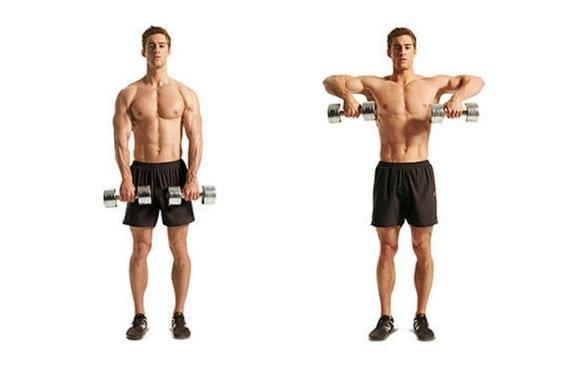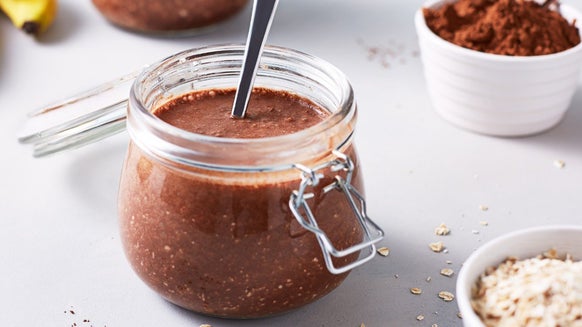How To Do A Barbell Upright Row | Benefits & Technique

If you're looking to sculpt stronger shoulders and improve your overall physique, you should look at adding upright rows into your training.
Barbell upright rows are great upper body exercise that can fit perfectly into your existing training plans. From shoulder and arm workouts to full-body routines, upright rows should be an essential addition to your training. Here's why...
What is a barbell upright row?
When performed correctly, the barbell upright row can be a fantastic muscle-building exercise for the upper back and shoulders, which can help to shape your upper arms and torso.
Start by grabbing a barbell with your hands, slightly narrower than shoulder-width apart. Without swinging your hips, pull the barbell to your upper chest, and then lower the weight back down in a controlled manner.
Upright rows are a free-weight exercise, usually performed using dumbbells or a barbell. It’s a simple exercise but requires perfect execution to achieve the best results and avoid injury. Follow our tips on how to master this exercise.
The benefits of a barbell upright row and the muscles targeted
The upright row is an upper body exercise that predominantly targets the anterior and lateral deltoids (the muscle that runs along the front and outside of your shoulder respectively), which is responsible for adding width to your shoulders. Wider appearing shoulders can help your waist appear smaller, whilst toning and shaping your upper arm and shoulders.
This exercise also challenges your trapezius (traps), a large muscle in the back that helps you shrug your shoulders, as well as the rhomboids, and even the biceps — making it a great addition to any full-body workout.
In addition to strengthening and sculpting the shoulders, mastering the barbell upright row can help you with those bigger lifts like squats and deadlifts.
How to perform an upright row
Muscles targeted: Deltoids (anterior & lateral), upper fibres of trapezius, rhomboids, rotator cuff muscles, biceps.
Equipment: Straight barbell, E-Z curl barbell, cable machine, dumbbells, kettlebell
- Starting with the barbell at your feet, grip the bar with your hands, slightly narrower than shoulder-width apart. Brace your core and squeeze your glutes - this will minimise the amount of swinging that occurs and will help to prevent your lower back from sustaining an injury
- Raise your elbows and lift the barbell until your elbows are level with your shoulders. During the movement, it’s important to keep the barbell under control. Keeping the barbell close to your body (or centre of mass) will help to reduce the chance of swinging the barbell forwards.
- Pause at the top before lowering the weight back to the starting position in a controlled manner.
- Repeat for the desired amount of reps.
Technique Tips
Bracing your core during this movement can help you reduce the amount of strain on your lower back and will ensure the focus of the exercise is on your deltoids. Swinging and using your hips defeats the purpose of the exercise, so make sure to control the movement, and reduce the load in favour of improving technique if necessary.
Common mistakes and how to fix them
1. Lifting your elbows too high
Controlling the movement and limiting your elbows to reach the same height as your shoulders ensure you are not exerting your shoulder and potentially causing an injury. During the barbell upright row, one of the joints at the shoulder (known as the acromioclavicular joint) can pinch the supraspinatus tendon, resulting in pain, irritation and inflammation.
Stopping your elbows at (or just below) shoulder height will help reduce the risk of injury. If your gym doesn’t have a mirror, a good rule of thumb is when your hands reach your sternum, your elbows will be around shoulder height.
2. Letting your upper back round & shoulders roll forward
When lowering the barbell, make sure your chest is proud and your shoulders pulled back/together (known as scapular retraction). Retracting the scapulae puts the shoulders in a strong position to lift and will help focus the exercise on the deltoids, whereas allowing the shoulders to roll forward places more of the load on the traps, which is not our main focus for this exercise.
3. Lifting too heavy
Too often, people will pile on as much weight as they can handle, believing that this is the secret to packing on the muscle. While progressive overload is essential for increasing the stimulus and thus facilitating muscle growth, caution should be taken with this exercise – focusing primarily on stimulating the target muscles without placing excessive stress on surrounding passive soft tissue structures.
Instead of piling on the kilo’s, try increasing the number of sets, reps or time under tension, or reduce the rest period between sets to increase the stimulus to the muscle.
Variations and alternative exercises
1. Dumbell upright row
Upright rows can be performed using dumbbells or a barbell. You can use this dumbbell variation if you feel restricted in your wrists or shoulders, as this exercise allows for more freedom in the movement.
https://youtu.be/r93Obscp_xo
- Hold a dumbbell in each hand with a pronated grip - slightly narrower than shoulder-width apart. Your arms should be extended with a slight bend at the elbows and your back straight. This is your starting position.
- Lift your elbows and raise the dumbbells until your elbows are level with your shoulders. During the movement, keep the dumbbells moving in a straight up-and-down motion. Try not to let them swing forward, keeping the dumbbells close to your body.
- Pause at the top, then lower the weight back down in a controlled manner.
- When the dumbbells are back at the start position, brace your core and glutes again, and repeat the steps.
2. Lateral raise
Lateral raises are one of the best exercises for sculpting shoulders. This is a very simple movement where you raise weights to the sides and up to shoulder level, then lower them again. Sounds simple, but not necessarily easy…
https://youtu.be/WNGmYlRVkwA
- Take a light/moderate dumbbell in each hand and hold them at your sides.
- With a slight bend in your elbow, raise the dumbbells upwards until they are level with your shoulders, pause, and return to the start position.
3. Seated lateral raise
This is the same movement as the lateral raise, but this time you'll be sat down on a bench.
https://youtu.be/n90_Kf2R1SI
- Sit on a bench, holding a dumbbell in each hand by your sides.
- Raise the dumbbells to your side until they're level with your shoulders.
- Lower the dumbbells back to the starting position. Keeping them under control throughout the whole movement.
- Repeat for the desired amount of reps.
Smith Machine Shoulder Press
The smith machine shoulder press is a great way to target all the muscles in your shoulder. Using the smith machine helps to keep your muscles under tension throughout the whole movement, and is generally safer and less strenuous on the joints — compared to free weight training.
https://youtu.be/Mg_HSeDU-iU
- Place a flat bench under a smith machine. The barbell should be positioned at a height where your arms are almost fully extended to reach it.
- Grab the barbell with your palms facing forwards. Unlock the bar and press your arms up until they're fully extended. This will be your starting position.
- Slowly lower the barbell below the chin and just above chest height.
- Lift the barbell back to the starting position.
Take home message
The upright row is an almost total upper body movement, targeting your shoulders, traps, forearms and biceps. You can alter the movement by switching to dumbbells or by isolating your lateral delts further by utilising lateral raises.
Try placing this exercise early on in your workout as it involves a lot of muscles, and you will want to smash this one whilst you’re fresh.






